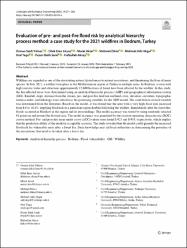| dc.contributor.author | Yilmaz, Osman Salih | |
| dc.contributor.author | Eren Akyüz, Dilek | |
| dc.contributor.author | Aksel, Murat | |
| dc.contributor.author | Dikici, Mehmet | |
| dc.contributor.author | Akgül, Mehmet Adil | |
| dc.contributor.author | Yağcı, Oral | |
| dc.contributor.author | Şanlı, Fusun Balık | |
| dc.contributor.author | Aksoy, Hafzullah | |
| dc.date.accessioned | 2024-04-04T17:36:04Z | |
| dc.date.available | 2024-04-04T17:36:04Z | |
| dc.date.issued | 2023 | en_US |
| dc.identifier.citation | Yılmaz, Osman S., Eren Akyüz, D., Aksel, M., Dikici, M., Akgül, Mehmet A., Yağcı, O., Şanlı, Füsun B., Aksoy, H. (2023). Evaluation of pre‑ and post‑fre food risk by analytical hierarchy process method: a case study for the 2021 wildfres in Bodrum, Turkey. Landscape and Ecological Engineering, 19, 271-288. | en_US |
| dc.identifier.uri | https://hdl.handle.net/20.500.12846/1021 | |
| dc.description.abstract | Wildfres are regarded as one of the devastating natural disturbances to natural ecosystems, and threatening the lives of many
species. In July 2021, a wildfre took place in the Mediterranean region of Turkey in multiple areas. In Bodrum, a town with
high touristic value and attraction, approximately 17,600 hectares of forest have been afected by the wildfre. In this study,
the fre-afected areas were determined using an analytical hierarchy process (AHP) and geographical information system
(GIS). Rainfall, slope, distance from the stream, pre- and post-fre land use and land cover, elevation, curvature, topographic
wetness index, and lithology were selected as the governing variables for the AHP model. The contribution of each variable
was determined from the literature. Based on the model, it was found that the area with a very high food risk increased
from 8.6 to 18.4%, implying food risk in a particular region doubled following the wildfre. Immediately after the forest fre,
foods occurred in Mazikoy in the region and its surroundings. The model accuracy was tested by using randomly selected
61 points in and around the fooded area. The model accuracy was quantifed by the receiver operating characteristic (ROC)
curves method. Pre- and post-fre areas under curve (AUC) values were found 0.925 and 0.933, respectively, which implies
that the prediction ability of the model is acceptably accurate. The study revealed that the model could quantify the increased
food risk for vulnerable areas after a forest fre. Such knowledge may aid local authorities in determining the priorities of
the precautions that need to be taken after a forest fre. | en_US |
| dc.language.iso | eng | en_US |
| dc.relation.isversionof | 10.1007/s11355-023-00545-x | en_US |
| dc.rights | info:eu-repo/semantics/openAccess | en_US |
| dc.subject | Analytical hierarchy process | en_US |
| dc.subject | Bodrum | en_US |
| dc.subject | Flood vulnerability | en_US |
| dc.subject | GIS | en_US |
| dc.subject | Wildfre | en_US |
| dc.title | Evaluation of pre‑ and post‑fre food risk by analytical hierarchy process method: a case study for the 2021 wildfres in Bodrum, Turkey | en_US |
| dc.type | article | en_US |
| dc.relation.journal | Landscape and Ecological Engineering | en_US |
| dc.identifier.issue | 19 | en_US |
| dc.relation.publicationcategory | Makale - Uluslararası Hakemli Dergi - Kurum Öğretim Elemanı | en_US |
| dc.contributor.department | TAÜ, Mühendislik Fakültesi, İnşaat Mühendisliği Bölümü | en_US |
| dc.identifier.startpage | 271 | en_US |
| dc.identifier.endpage | 288 | en_US |

















